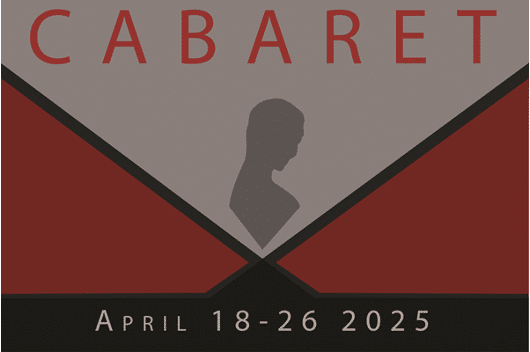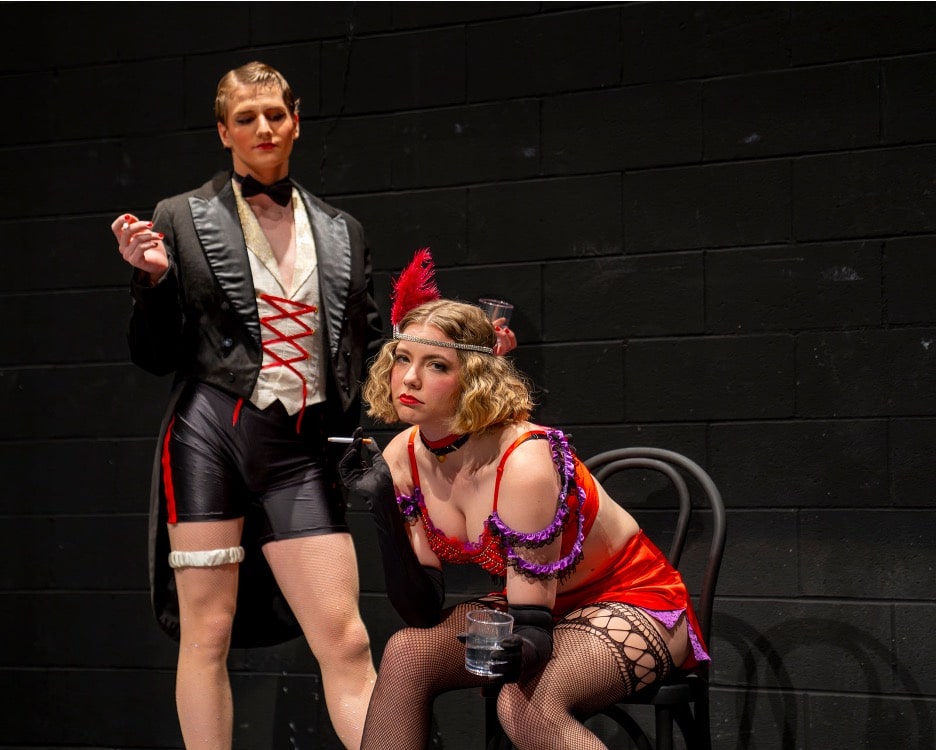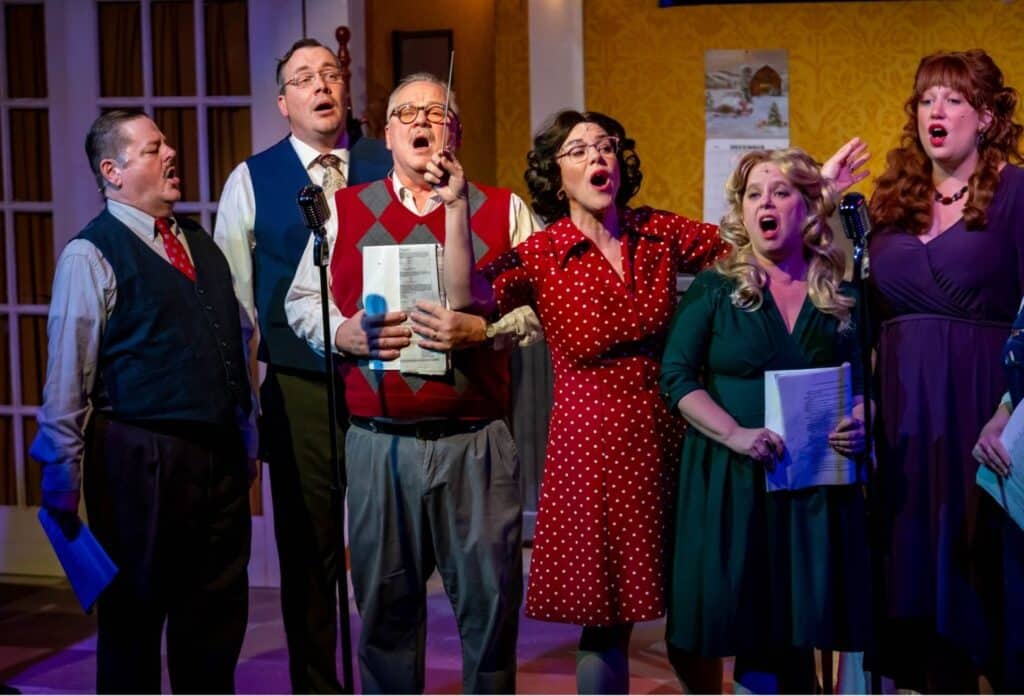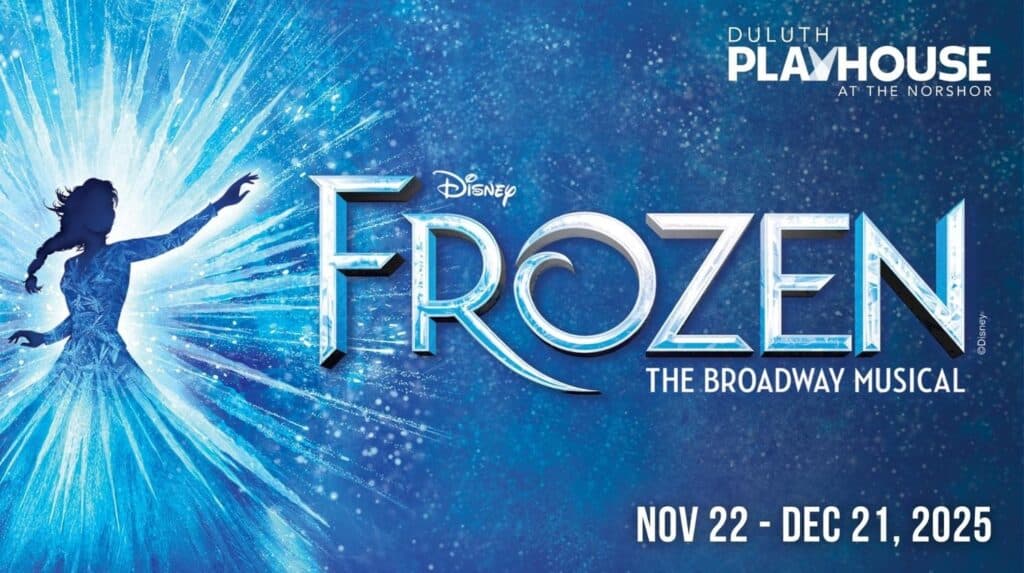
By Sheryl Jensen
UMD Theatre has chosen to produce the musical “Cabaret” at a moment when it undeniably speaks to today more than it has done since the chilling pre-WWII days in Berlin, Germany, a time filled with a sense of impending doom
“Cabaret,” in the 1972 legendary film musical and worldwide professional and amateur productions, including the current Broadway revival, has long been an unsettling cautionary tale, warning of the perils of intolerance and the need for people to find the moral courage to stand up and speak out.
In Act I, the audience can enjoy the decadent, bawdy, and audacious world of the Kit Kat Club. In Act II, however, that world comes crashing down, and the political realities of the day become alarmingly real.
As characters are silently complicit, ignoring the ever-increasing rise of fascism by keeping their heads down and their mouths shut, the music keeps playing, and the scantily dressed women keep dancing.
Ordinary people living their ordinary lives such as the forlorn landlady Fräulein Schneider (Elsa Persson) feel helpless and afraid, thinking that if they can just survive the whirlwind, life can go back to normal.
Persson, in a mature and heartbreaking performance, has one of the show’s most powerful moments in her song “What Would You Do?” When she sings,
“Suppose simply keeping still
Means you manage until the end?
What would you do
My brave young friend?”
she captures the feelings of many other ordinary citizens trying to decide their best course of action.
Sadly, Fräulein Schneider loses a chance for love and companionship with Herr Schultz (Ryan Sternbaum), the meek and mild Jewish fruit seller. Their sweet relationship in the songs “It Couldn’t Please Me More” and “Married” is irrevocably shattered, echoing the sound of glass shattering from a brick thrown through Schultz’s shop window.
The scene was reminiscent of the real Kristallnacht, “the night of broken glass” in November of 1938, the Nazi dictatorship’s waging a precursor to war against German and Austrian Jews by vandalizing their shops and ransacking their homes.
Any actress playing Sally Bowles has to contend with the long shadow of Liza Minnelli, the coquettish, audacious, and outlandish original Sally Bowles. Sally (Courtney Larson)represents the naive people consumed by self-interest and oblivious to what was going on all around them. Larson best showcased her characterization in her strong dancing in her numbers with the Kit Kat girls, as the clear star of the Club.
Larson, however, sang the title song “Cabaret” as more shrill and angry and, as the song went on, more physically weakened than is typically the case. While the title song is often played as more of a power ballad and a declaration of Sally’s life choices, these less expected vocal choices were a bit jarring.
Tanner Rex Longshore also has to contend with the Joel Grey’s indelible film characterization of the Emcee and numerous other legendary Emcees, including Alan Cumming and most recently Eddie Redmayne and Adam Lambert.
Longshore starts the show strongly with his admonition to the audience to “Leave your troubles outside! So-life is disappointing? Forget it! In here life is beautiful-the girls are beautiful-even the orchestra is beautiful!” His sarcasm, lechery for both “ladies und gentlemen,” and his pop up characters with quick costume changes, are also important to lighten the mood.
Longshore’s strong physical presence, over-the-top characterization, and sleazy costumes help him to command every scene in which he appears. His character starts out using broad humor and double entendres before he too becomes broken and lost, takes off his makeup, and puts on an everyday shirt and pants, before donning his shocking costume reveal at the show’s end.
The American writer Clifford Bradshaw (Aaron Dumalag) is always a somewhat problematic and ambiguous character, starting as a naive innocent, and then being drawn into the darker side of Berlin’s “nightlife” and the Nazi preparations for war.
His character arc shows him straying from the moral path in his dealings with Ernest Ludwig, a Nazi, and his own willingness just to enjoy life by ignoring the realities of the Berlin he came to write about.
Dumalag has just a few opportunities to use his wonderful singing voice, including in a duet with Sally, “Perfectly Marvelous.” He shows his character as wistful, sad, and broken, too, in a final passage he is writing. “There was a cabaret and there was a master of ceremonies and there was a city called Berlin in a country called Germany—and it was the end of the world and I was dancing with Sally Bowles— and we were both fast asleep…”
A standout performance came from Hope Davis as Fräulein Kost, the humorous hooker with the roomful of young soldiers trying to get out of the building to evade Fräulein Schneider’s watchful eye. Davis also had two of the strongest vocals in her solos in “Married” and in “Tomorrow Belongs to Me Reprise.”
As the show’s powerful Nazi-inspired anthem “Tomorrow Belongs to Me” begins as an intended message of German patriotism with a seemingly positive message for the future, it quickly devolves into a threat of nationalism run amok.
Scenic Designer Curtis Phillips (and his assistant scenic and props designers Emma Wylie and Kate Bakke) created an impressive set consisting of levels on each side of the major central acting space, a large central wall with two doors, and a bright red curtain, leaving a large central acting space with simple set pieces moved on and off to create a variety of locales.
With the theatrical bare light bulbs, shadowy nooks and crannies, and bold lighting choices for songs and scenes, lighting designer Jacob Stein and assistant Vivi Tbor were also instrumental in creating a stunning visual and distinctive ambiance.
While the sound worked well for the songs, the dialogue was lost at times with low projection from some actors and a need for louder and clearer sound levels.
Also, with the band’s position behind a wall and a curtain, and being quite upstage, they too were harder to hear, particularly in Act I, where they sounded muffled at times. The band’s sound balance improved, on the whole, in Act II.
Some of the fun and excitement in “Cabaret” can be had with the band being very visible, costumed (with the men in drag), and even more of an integral part of the action. The choice not to do that made the experienced pit band less significant than it might have been.
Choreographer Matthew Wagner captured both the raunchiness and sexiness of the Kit Kat Club in raucous numbers particularly in Act I’s “Don’t Tell Mama,” “Mein Herr,” and the hysterical “Two Ladies,” The Kit Kat ensemble, particularly the women, were convincing in their challenging dance numbers.
The much darker Act II begins with “Kickline,”a song that starts as a high-energy production number, echoing Act I’s numbers of Sally and the Kit Kat girls, but devolving in a chilling turn with military goose steps and a fervent homage to Nazi storm troopers.
With the strings of bare light bulbs, shadowy nooks and crannies, and bold lighting choices for songs and scenes, Jacob Steen’s lighting design (assisted by Vivi Tabor) helped create mood, atmosphere and even tone.
Caitlin Quinn (with assistant costume designer Jennika Bunney) created colorful, period-style, sexy designs, particularly for Sally and the Kit Kat dancers.
The Marshall Performing Arts Center lobby’s walls were filled with period photographs and evocative quotes, including the famous one from German theologian and Lutheran pastor Martin Niemöller.
“First they came for the socialists, and I did not speak out — because I was not a socialist. Then they came for the trade unionists, and I did not speak out — because I was not a trade unionist. Then they came for the Jews, and I did not speak out — because I was not a Jew. Then they came for me — and there was no one left to speak for me.”
Bravo to UMD Theatre, Cabaret’s director Thomas Jacobsen, and the cast and team for giving their audiences a warning about what is happening today and the question, “Who does the future belong to?” And what role will each of us play now and in that future?”

Information on UMD’s “Cabaret”
Written by Joe Masteroff, Music by John Kander, Lyrics by Fred Ebb
Directed by Thomas Jacobsen
April 22, 23, 24, 25 | 7:30 PM
April 26 | 2:00 PM & 7:30 PM
UMD’s Marshall Performing Arts Center Main Stage
Advance tickets are available at https://z.umn.edu/UMDCabaret or at 218-726-8561. Advance tickets $25 adult | $20 senior/UMD Faculty & Staff/Veteran | $10 all students. UMD students are also eligible for free rush tickets 30 minutes prior to a performance with a valid UMD student ID; subject to availability.
Set at the Kit Kat Klub in 1931 Berlin, where the Master of Ceremonies ushers the audience through the story of Cliff, a young American writer, who is immediately taken with English singer Sally Bowles. Meanwhile, Fräulein Schneider, proprietor of Cliff and Sally’s boarding house, tentatively begins a romance with Herr Schultz, a mild-mannered fruit seller who happens to be Jewish. Based on the 1998 Broadway revival, the show explores the dark, heady, and tumultuous life of Berlin’s natives and expatriates as Germany slowly yields to the emerging Third Reich. (From UMD Theatre
Attendees should be advised that “Cabaret” explores sensitive issues such as anti-Semitism, Nazism, racism, homophobia, transphobia, sexism, and abortion. This production also includes profanity, sexual content, physical depictions of violence, smoking, drug use, and alcohol use.
In partnership with UMD’s Baeumler-Kaplan Holocaust Commemoration Committee, performances on d Friday, April 25 will be followed by talks putting the events of the play into historical context. Since 1996, the Baeumler-Kaplan Holocaust Commemoration Committee has existed to inform and educate the UMD community about the Holocaust, its victims, causes, consequences, lessons, legacies, and memory. Members of the cast and creative team will also be on hand to discuss the process that went into bringing these stories to the stage.









